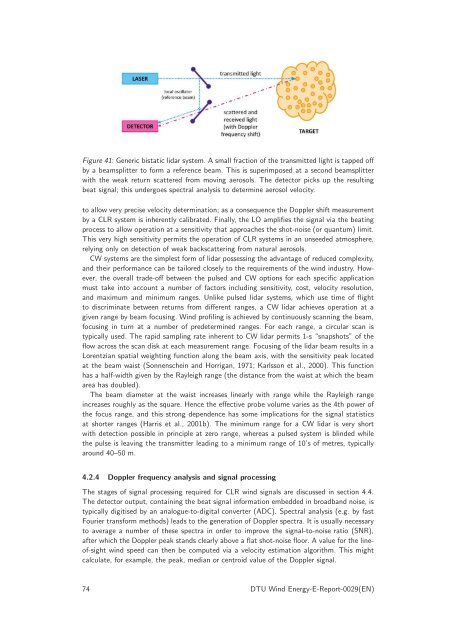Publishers version - DTU Orbit
Publishers version - DTU Orbit
Publishers version - DTU Orbit
You also want an ePaper? Increase the reach of your titles
YUMPU automatically turns print PDFs into web optimized ePapers that Google loves.
Figure 41: Generic bistatic lidar system. A small fraction of the transmitted light is tapped off<br />
by a beamsplitter to form a reference beam. This is superimposed at a second beamsplitter<br />
with the weak return scattered from moving aerosols. The detector picks up the resulting<br />
beat signal; this undergoes spectral analysis to determine aerosol velocity.<br />
to allow very precise velocity determination; as a consequence the Doppler shift measurement<br />
by a CLR system is inherently calibrated. Finally, the LO amplifies the signal via the beating<br />
process to allow operation at a sensitivity that approaches the shot-noise (or quantum) limit.<br />
This very high sensitivity permits the operation of CLR systems in an unseeded atmosphere,<br />
relying only on detection of weak backscattering from natural aerosols.<br />
CW systems are the simplest form of lidar possessing the advantage of reduced complexity,<br />
and their performance can be tailored closely to the requirements of the wind industry. However,<br />
the overall trade-off between the pulsed and CW options for each specific application<br />
must take into account a number of factors including sensitivity, cost, velocity resolution,<br />
and maximum and minimum ranges. Unlike pulsed lidar systems, which use time of flight<br />
to discriminate between returns from different ranges, a CW lidar achieves operation at a<br />
given range by beam focusing. Wind profiling is achieved by continuously scanning the beam,<br />
focusing in turn at a number of predetermined ranges. For each range, a circular scan is<br />
typically used. The rapid sampling rate inherent to CW lidar permits 1-s “snapshots” of the<br />
flow across the scan disk at each measurement range. Focusing of the lidar beam results in a<br />
Lorentzian spatial weighting function along the beam axis, with the sensitivity peak located<br />
at the beam waist (Sonnenschein and Horrigan, 1971; Karlsson et al., 2000). This function<br />
has a half-width given by the Rayleigh range (the distance from the waist at which the beam<br />
area has doubled).<br />
The beam diameter at the waist increases linearly with range while the Rayleigh range<br />
increases roughly as the square. Hence the effective probe volume varies as the 4th power of<br />
the focus range, and this strong dependence has some implications for the signal statistics<br />
at shorter ranges (Harris et al., 2001b). The minimum range for a CW lidar is very short<br />
with detection possible in principle at zero range, whereas a pulsed system is blinded while<br />
the pulse is leaving the transmitter leading to a minimum range of 10’s of metres, typically<br />
around 40–50 m.<br />
4.2.4 Doppler frequency analysis and signal processing<br />
The stages of signal processing required for CLR wind signals are discussed in section 4.4.<br />
The detector output, containing the beat signal information embedded in broadband noise, is<br />
typically digitised by an analogue-to-digital converter (ADC). Spectral analysis (e.g. by fast<br />
Fourier transform methods) leads to the generation of Doppler spectra. It is usually necessary<br />
to average a number of these spectra in order to improve the signal-to-noise ratio (SNR),<br />
after which the Doppler peak stands clearly above a flat shot-noise floor. A value for the lineof-sight<br />
wind speed can then be computed via a velocity estimation algorithm. This might<br />
calculate, for example, the peak, median or centroid value of the Doppler signal.<br />
74 <strong>DTU</strong> Wind Energy-E-Report-0029(EN)

















